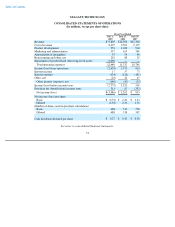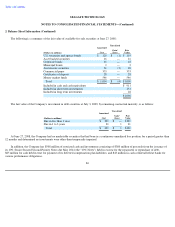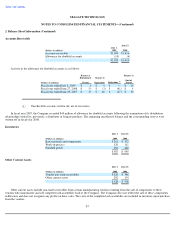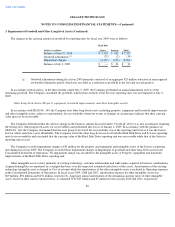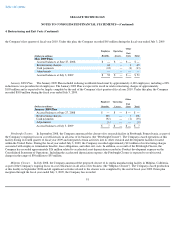Seagate 2008 Annual Report Download - page 84
Download and view the complete annual report
Please find page 84 of the 2008 Seagate annual report below. You can navigate through the pages in the report by either clicking on the pages listed below, or by using the keyword search tool below to find specific information within the annual report.
Table of Contents
SEAGATE TECHNOLOGY
NOTES TO CONSOLIDATED FINANCIAL STATEMENTS—(Continued)
1. Summary of Significant Accounting Policies (Continued)
required to reduce its manufacturing operations, which could have a material adverse effect on its results of operations. In addition, the Company
has made prepayments to certain suppliers. Should these suppliers be unable to deliver on their obligations or experience financial difficulty, the
Company may not be able to recover these prepayments.
Newly Adopted and Recently Issued Accounting Pronouncements
In June 2009, the FASB issued SFAS No. 168, The FASB Accounting Standards Codification and the Hierarchy of Generally Accepted
Accounting Principles
—a replacement of SFAS 162 (SFAS No. 168), establishing codification, which integrates and categorizes all guidance by
standard setters within levels A through D of the previous GAAP hierarchy. SFAS No. 168 will replace all existing GAAP for non-
governmental
entities and will establish a new hierarchy of GAAP, both authoritative and non-authoritative. SFAS No. 168 is effective for interim and annual
periods ending after September 15, 2009 and will be adopted by the Company beginning in the first quarter of its fiscal year 2010. The Company
does not expect the adoption to have a material impact on its consolidated results of operations and financial condition.
In June 2009, the FASB issued SFAS No. 167, Amendments to FASB Interpretation No. (FIN) 46(R) (SFAS No. 167), which amends
consolidation analysis guidance for variable interest entities, or VIE's. SFAS No. 167 is effective for annual periods beginning after
November 15, 2009. The Company is currently evaluating the impact of the pending adoption of SFAS No. 167 on its consolidated results of
operations and financial condition.
In June 2009, the FASB issued SFAS No. 166, Accounting for Transfers of Financial Assets—an amendment of FAS 140 (SFAS No. 166),
which amends de-
recognition guidance in FAS 140 for transfers of financial assets. SFAS No. 166 is effective for annual periods beginning after
November 15, 2009. The Company is currently evaluating the impact of the pending adoption of SFAS No. 166 on its consolidated results of
operations and financial condition.
In May 2009, the FASB issued SFAS No. 165, Subsequent Events (SFAS No. 165), which updates previous guidance under GAAP by
replacing "type 1" and "type 2" with "recognized" and "unrecognized," and requires disclosure in financial statements of the date through which
subsequent events have been evaluated. SFAS No. 165 is effective for interim and annual periods ending after June 15, 2009 and was adopted by
the Company beginning in the fourth quarter of its fiscal year 2009. The adoption of SFAS No. 165 did not have a material impact on the
Company's consolidated results of operations and financial condition.
In April 2009, the FASB issued FASB Staff Position (FSP) SFAS No. 157-4, Fair Value Measurements (FSP No. 157-
4), which supercedes
FSP SFAS 157-
3 and provides additional guidance on estimating fair value when volume and level of transaction activity for the asset or liability
have significantly decreased. FSP SFAS No. 157-
4 is effective for interim and annual periods ending after June 15, 2009 and was adopted by the
Company in the fourth quarter of its fiscal year 2009. The adoption of FSP SFAS No. 157-4 did not have a material impact on the Company's
consolidated results of operations and financial condition.
In April 2009, the FASB issued FASB FSP SFAS No. 115-2 and SFAS No. 124-2, Recognition and Presentation of Other-Than-
Temporary
Impairments
(FSP No. 115-2 and SFAS No. 124-2), which provides operational guidance for determining other-than-temporary impairments for
debt securities. FSP
82



